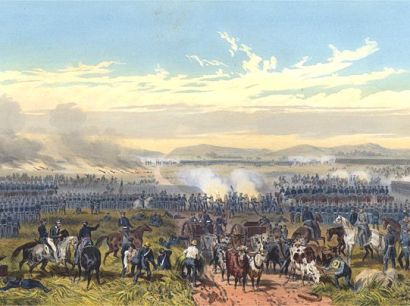This Week's Story
The first major battle of the Mexican-American War featured meritorious bravery and exceptional use of artillery.

This Week’s Story relives American history and the Bible through brief inspiring stories presented on mp3 audio recordings and text for reading.
You Do Not Own Me! part six
“Today, May 7, 1846, at 3:00 P.M., we march! The enemy is blocking the road to Matamoros at a place called Palo Alto. If my orders are accomplished, I have no doubt what the result will be, no matter how many soldiers meet us.
“The battalions of Infantry will mainly depend on their bayonets.” General Zachary Taylor’s voice was steady. Old Rough and Ready knew battle and he cared for his men. They were entering the first major battle of the Mexican-American War.
The American regular infantry was tense, but relieved to have hand-to-hand combat. It was better than depending on their inaccurate flintlock-muskets. Bayonets on their muskets would be best for close-in fighting.
The Mexican military forces under General Arista awaited the Americans. They outnumbered the Americans. Many were determined professional soldiers.
General Taylor thought: My men are eager volunteers. Some have excellent skill with their guns and artillery. The Texans have inner fire to maintain their Texan independence. The Rangers have stunning
precision with their Colt revolvers. Our artillery range and speed will shock the enemy. The West Point graduates with us have studied battle strategies, but they have no combat experience.
At 3:00 P.M. the Americans travelled forward with 2,000 men, 200 supply wagons, and two enormous 18-pounder cannons. 20 oxen were required to move them. Each weighed 3,000 pounds. Each projectile was a shell that weighed 18.5 pounds with a maximum range of 2,000 yards.
The parade included 14 light-weight bronze short-barreled cannon. These could be fired and reloaded in ten seconds with well-trained crews and astonishing swiftness!
The American soldiers travelled eleven miles and set up camp. The Mexican soldiers received reinforcements. By morning they had 5,000 troops. On the road General Arista had 12 cannons. Two were 8-pounders. His treasure was 1,500 mounted lancers.
At midday the Americans arrived. Infantry walked in a long line with bayonets positioned for use. Mexican bands began playing “Vive La Republica.” Banners waved.
General Taylor deployed his companies into battle position. He gave them time to fill their canteens with fresh water and recover from their march, while the enemy sweat in parade attention.
General Taylor ordered, his troops, “Advance! No talking! No shouting!” An odd quiet reigned on a coastal prairie with plants having dagger points.
General Arista ordered his artillery, “Open fire!” Their range was less than the Americans’ position of about 700 yards. The Americans brought eight 6-pounders to about 20 paces in front of their infantry. The two monster cannons were hauled in. The Americans’ highly mobile artillery cleared a road of death through the enemy.
American Lieutenant Sam Grant noted, “The Mexicans were uncommonly brave; they kept closing ranks and standing firm. Their flintlock muskets were woefully short-ranged.”
When General Arista sent a cavalry charge of 800 mounted lancers, Captain Smith used his West Point training to protect his troops.
The battle continued with death and bravery on both sides. During the night the Mexican Army decamped. Fighting resumed the next day.
How peculiar that this opening battle and the Mexican and American War would be given little attention in U.S. elementary and secondary schools. The war mirrored the complexity, confusion, courage, and stereotypes stirred in war.
Today Nathan Thomas and Scott Thomas were our dramatic readers. Barbara Steiner was the writer and researcher.
You are invited to thisweeksstory.com.
<< previous story] [next story >>
We invite your comments! [click here to comment]
This Week's Story is a non-profit supported by listeners. [click here to make a donation]
 click here to play audio
click here to play audio